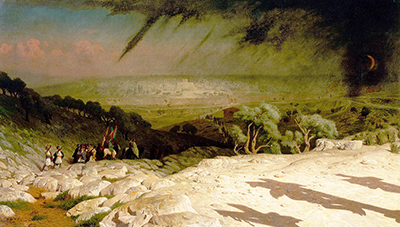Jerusalem is a painting created by Jean-Leon Gerome, a French painter and sculptor, in 1867. The painting is also referred to as Golgotha, The Crucifixion, and The Consumatum Est. This highly detailed piece was exhibited at the Salon in 1868. It has been located at the Musée d'Orsay in Paris since 1990.
Artwork Description
In the foreground, the artwork delineates the land of Golgotha and the shadows of three crucified individuals: Jesus Christ of Nazareth and two thieves. Slightly back in the image is a group of individuals leaving ceaselessly from the site. The background depicts an overcast and sunless Jerusalem City.
It was normal for Gerome not to portray a vicious occasion itself, but the fallout of such violence. This is evident in some of his other paintings such as The Death of Caesar and The Duel.
The Masquerade and The Execution of Marshal Ney
After the quest for Orientalism, Jerusalem denoted Gerome’s return to history painting. Like many Christian arts of that time, this painting was a result of the life of Jesus by Ernest Renan.
Gerome painted quite a few religious artworks. However, Jerusalem is striking for its utilization of the shadows of the crucified men. The evident use of the play of light turned out to be so vital to Impressionism.
When Gerome introduced his canvas Jerusalem, to the 1867 Salon, he was met with harsh criticism. This daring artwork baffled viewers as it is similar to a contemporary photographic shot. All the same, Jerusalem was published as a large oil canvas Burin engraving.
Techniques Used
Through Jean – Auguste Dominique and Paul Deroche, Gerome became proficient in a technique of painting that wiped out any hint of brushwork delivering an intricate impression of reality. His canvases show noteworthy photographic naturalism because of his precision. In fact, his critics admired his impeccable work and technique.
Some of the artist’s other works included the obedient prophet and Moses on Mt Sinai. Gerome was influenced by Charles Beke who commended him on his numerous works mostly on the Mt Sinai art piece. Today, Gerome is celebrated as one of the most creative and diverse artists of his time.




